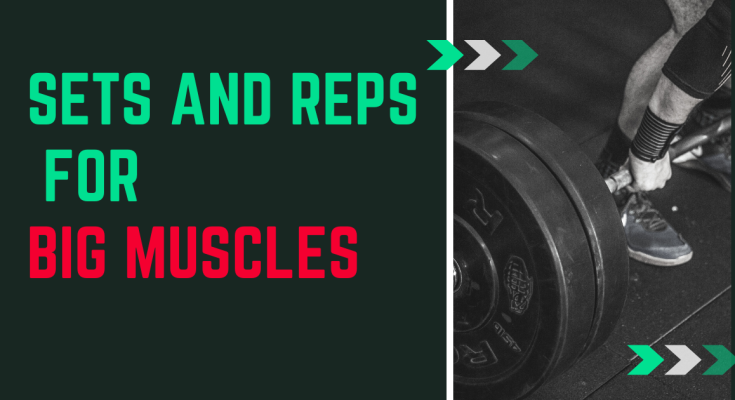Sets and reps for big muscles.

When it comes to building muscle, finding the optimal rep range and number of sets is crucial. Here’s a concise guide to help you navigate this aspect of your training:
Rep Range for Muscle Growth
For hypertrophy (muscle growth), the most effective rep range typically falls between 6 to 12 reps per set. This range strikes a balance between lifting heavy enough to stimulate muscle fibers and performing enough repetitions to induce muscle fatigue.
– 6-8 Reps: This range is effective for increasing strength and building muscle mass, as it allows you to lift heavier weights.
– 8-12 Reps: This is considered ideal for hypertrophy, providing a good mix of muscle tension and metabolic stress, which are key for muscle growth.
Number of Sets per Body Part or Session
– Per Body Part: Aim for 3 to 5 sets per muscle group. This volume is generally effective for stimulating muscle growth without overtraining.
– Per Session: For a comprehensive workout, 6 to 12 sets per muscle group per week is commonly recommended. This can be split across different sessions, depending on your workout split.
Additional Tips
– Intensity and Form: Regardless of rep range and sets, maintaining proper form and intensity is essential for maximizing muscle growth and minimizing injury risk.
– Progressive Overload: Continuously challenge your muscles by gradually increasing weights or reps over time to ensure ongoing growth.
This approach will help you build a solid foundation and make consistent progress in your muscle-building journey.

Strength vs. size
When discussing rep ranges, the focus varies based on the specific training goal. For those aiming to build strength, the typical rep range is below 6 reps per set, which allows for lifting heavier weights. On the other hand, if the goal is to build muscle size, the rep range is usually around 8 to 12 reps per set. This range provides a balance between sufficient weight and volume to promote muscle growth. For those interested in muscular endurance or conditioning, a higher rep range of 12 to 15 or more is often used to improve stamina and overall conditioning.

High reps
When it comes to rep ranges, high repetitions, typically above 20, are primarily used for endurance training rather than building significant muscle size or strength. For instance, Floyd Mayweather, known for his extensive push-up routines, demonstrates this concept well. Despite his high volume of push-ups, which could exceed 1,000 per day, his physique is more lean and not particularly bulky. This illustrates that very high rep ranges do not necessarily lead to increased muscle mass.
The misconception that high rep training builds muscle stems from the intense burning sensation and soreness experienced during such workouts. While high reps can indeed create a burn and muscle soreness, this does not equate to significant muscle growth. Muscles worked with very high reps often end up less dense and harder to define compared to those trained with moderate rep ranges and heavier weights.
For optimal muscle building, focusing on moderate rep ranges of 8 to 12 reps per set is generally more effective. This range balances the load and volume needed to stimulate muscle growth. Lower rep ranges, such as 5 to 6 reps, are better suited for building strength, while reps extending to 15 or 16 can still support muscle growth but should not exceed this limit significantly.

Different muscle fibers in your body respond differently to various types of training. Heavy weights with an optimal rep range, typically around 6 to 12 reps, are effective for developing both muscle size and hardness. This approach recruits a mix of fast-twitch muscle fibers, which are essential for generating muscle mass and strength.
On the other hand, very high repetitions primarily target endurance and can improve the muscle’s shape and endurance capacity. This type of training, often involving lighter weights and higher reps (e.g., 20 or more), is beneficial for enhancing muscle endurance and reducing fat around the muscles, but it doesn’t contribute significantly to muscle size or density.
In summary, if your goal is to build substantial muscle size and hardness, focusing on moderate to heavy weights with lower to moderate rep ranges is more effective than high-rep endurance training alone.

Big Myth
The idea that there’s a one-size-fits-all rep range or weight for everyone is indeed a myth. Personal fitness recommendations should be tailored to individual needs, goals, and physical conditions. Factors like strength, experience level, and daily physical state can vary greatly from person to person, making it impractical for anyone to prescribe a universal weight or rep range that suits everyone.
For example, one person’s optimal rep range for building muscle might be 8-12 reps with a certain weight, while another person might achieve better results with a different rep range or weight. Additionally, a person’s strength and endurance can fluctuate daily due to various factors such as rest, nutrition, and overall health.
Effective training should be personalized and adaptive, meaning that it should be adjusted based on individual progress and responses. Fitness professionals should consider these factors and work with clients to find the right balance of weight and rep range that aligns with their specific goals and conditions.

Variation in strength with days
If I have a rough day, didn’t sleep well, and then head to the gym, I won’t be able to lift the same weights or perform the same number of reps as I usually do. For instance, if I normally get around 14 reps with 45 kg on bicep curls, on such a day, I might only manage 8 or 10 reps. This happens because my body isn’t fully recovered and is more fatigued. Since physical condition and strength can vary daily, it’s impractical to prescribe a fixed rep range or weight for everyone. Strength fluctuates, so even with years of experience, I can’t predict my exact performance for any given workout session. Prescribing a set number of reps and weights without considering individual variability is unrealistic and often reflects a lack of personalized attention. It seems that some trainers might offer these rigid plans just to simplify their work or increase profits, neglecting the importance of adapting to each client’s unique needs and current physical state.

An example of bad training plans
Imagine a person who’s advised by their trainer to lift 30 kg for 15 reps on a bicep curl. If this person hasn’t reached 70% of their failure point and could have managed more reps—say, their actual failure point is 22 reps but they stopped at 15 because of their trainer’s instruction—they won’t be maximizing their muscle growth. To build muscle effectively, you need to push close to or beyond failure. Relying solely on your trainer, workout partner, or online experts without understanding your own body’s limits can hinder your progress. It’s crucial to listen to your body and adjust your rep range according to your own strength and fatigue levels.

Sets for best growth
When it comes to the number of sets you should do, quality outweighs quantity. If your technique is poor, your intensity is low, or you’re not performing the exercises correctly, the number of sets becomes irrelevant. In bodybuilding, there’s a concept known as “junk volume,” which refers to doing excessive sets without effectively targeting the muscle or achieving muscle fatigue. Whether you do 50, 60, or even 100 sets, if you’re not properly engaging the muscle and pushing it to its limits, you won’t see significant results. It’s more effective to focus on fewer sets but execute them with full intensity and correct form.
Dorian Yates
Consider Dorian Yates, one of the greatest bodybuilders of all time, who used to train for just 45 minutes a day. Given this short duration, how many sets do you think he could fit into his workout? Despite his limited time, he was a Mr. Olympia champion, highlighting the crucial role of intensity over sheer volume. If you focus on lifting the heaviest weight possible with proper form and push each set close to or beyond failure, your muscles will be thoroughly worked. After about eight to ten sets for a specific muscle group, your muscles will be adequately exhausted. There’s no need to perform 25 to 30 sets per muscle group in each session. Concentrate on intensity, technique, and pushing your muscles to their limits with each set, and you’ll achieve results without the need for excessive sets.



